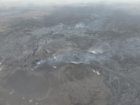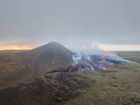News and alerts
Eruption at the Sundhnúkur crater row remains likely

Updated 25. March at 15:00 UTC
GPS deformation data shows that magma continues to accumulate beneath Svartsengi, although the pace of land uplift has slightly decreased in recent weeks. Despite the slower uplift, experts still consider it likely that a magma intrusion and/or eruption will occur along the Sundhnúkur crater row.
Read moreGround uplift under Svartsengi area continues at a stable rate

A photogrammetric survey was conducted by Icelandic Institute of Natural History and Landmælingar Íslands in a flight over the eruption site 13 December. The data reveals that the lava field that was formed during the last eruption (20 November to 9 December) had a total volume of 49,3 million cubic meters erupted and covered an area of 9,0 square kilometers. The thickest part of the lava field was around the craters and close to the barriers by the Blue Lagoon but the average thickness of the lava was 5,5 meters.
Read moreGround Uplift and Magma Accumulation Continue Beneath Svartsengi

Updated 19. November at 14:45 UTC
Seismic activity in the Sundhnúkar crater row remains relatively low. A few earthquakes have been recorded daily, most of them located between Stóra-Skógfell and Sýlingarfell. On some days in the past week, bad weather has affected the sensitivity of the seismic monitoring system, potentially obstructing the detection of the smallest earthquakes.
Read moreThe activity in the Reykjanes Peninsula has entered a new phase

Updated 10 August 2023
The Icelandic Met Office has updated the hazard map for the eruption site. The vicinity of the eruption area is still dangerous. High temperatures characterize the lava field. The solidified crust can be very thin in places with very hot and molten lava underneath. The edges of the new lava field are unstable and large chunks of lava can fall sudden. As a result of past activity there are fractures in the area that pose danger. The new lava continues degassing and hazardous gases can collect in depressions
Read moreRelated topics
- Instructions on using earthquake pages
- Bárðarbunga and Holuhraun 2014-2015 - overview
- Grímsvötn 2011 - overview
- Eyjafjallajökull 2010 - overview
- Useful links
- FutureVolc
- Road conditions
- Earthquake Engineering Research Centre - University of Iceland
- Incorporated Research Institutions for Seismology
- National Earthquake Information Center
- Preventive response to earthquakes



